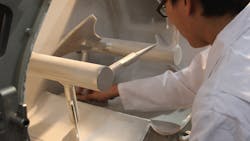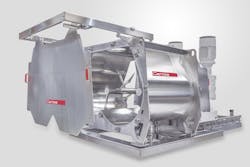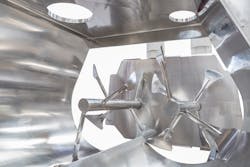How to avoid over-specifying mixing equipment
Companies processing powders and other bulk materials face significant safety and hygiene challenges in their plants.
Combustible dust explosions that seemingly occur out of nowhere strike fear into workers and managers alike. Machinery must eliminate the risk of product contamination and safeguard workers from injury, yet consistently deliver a high level of performance 24/7. Add the fear over COVID-19 and the daily reminders in hand sanitizers, facemasks and social distance signage, plus the threat of enforcement action by OSHA, FDA, USDA, EPA and health department inspectors always looming in the background, and it becomes easy to understand why companies may be over-spending to achieve a perceived level of hygiene that may be quite unnecessary. In fact, some owners and engineers are purchasing a variety of enhancements on their industrial mixers, blenders and other equipment “just in case” to guard against current and future unknowns. This over-specifying may provide some with peace of mind and an extra defense against potential issues, but it also carries a tangible cost and diverts needed funds from other areas that may yield greater returns.
Here are key considerations for assessing whether investing in an extra level of safety or contamination prevention makes sense or is simply a case of over-specifying.
Certifications
Earning regulatory approvals and third-party certifications conveys the mixer or other machinery meets specific requirements for hygiene, safety, quality, performance or other criteria. Many experienced powder processors know to look for these approvals and certifications as a mark of confidence during the purchasing process. However, manufacturers must invest substantial amounts of time, energy and money to earn these approvals and certifications, so their value typically comes with a higher cost than a standard model. It is important to determine which approvals and certifications are worth the cost and which are probably over-specifying.
ATEX is becoming widely recognized in North America as a useful symbol representing explosion prevention and protection. A requirement in the EU since 2014, the ATEX certification covers equipment and protective systems intended for use in potentially explosive atmospheres. This includes mixing equipment. Anyone mixing powders works in a potentially explosive atmosphere, though each process operates with more or less risk than another based on the layout of the facility, likelihood for ignition, the length of time combustible dust is exposed to the air and other factors. When processing in an ATEX environment, it is critical to specify ATEX-certified mixers, controllers, motors and other equipment since the science behind the certification has proven effective at preventing explosive events. It also offers a level of assurance in tandem with — and beyond — NFPA codes and standards. But this assurance of enhanced safety is also tempting processors who are not operating in ATEX environments to purchase ATEX-certified mixers anyway. For these situations, investing in ATEX-certified equipment to mix materials with little or no risk of an explosive event has to be considered as over-specifying.
The less widely recognized IECEx has global ambitions for its certification for equipment operating in hazardous, explosive environments. It offers the global standard in explosion protection for electrical equipment and its focus on independent, third-party testing may offer equipment buyers extra confidence. For mixing combustible materials in explosive environments, the IECEx certification serves as a useful mark, especially in tandem with ATEX, and is worth considering for maximum safety assurance. For processing in a non-hazardous environment, investing in an IECEx-certified mixer is simply over-specifying.
The CE certification is required by the EU on mixers and other equipment to be offered for sale within its boundaries. The CE represents a manufacturer’s declaration that the mixer or other equipment fulfills the EU health, safety and environmental protection requirements. This covers testing for electrical safety, performance and risk analysis, among other areas. Though not a requirement for buyers in North America, the CE certification has become an invaluable mark among some of the largest multinational companies since it offers future flexibility in the movement of equipment among facilities. The extra level of testing and accountability involved in securing the CE certification is also attractive to processors seeking surety of safe operation and quality manufacturing. For most buyers in North America, choosing a CE-certified mixer offers a documented level of performance and workmanship that is worth finding and specifying.
For processors and manufacturers involved in the food, dairy and beverage industries, specifying sanitary mixers featuring only FDA- and/or USDA-approved designs, materials and/or components is standard procedure. Mixers suitable for sanitary processing typically include stainless steel construction, continuously welded seems and polished internals to prevent bacterial growth, plus design consideration to minimize fasteners and allow easy access for complete cleaning and visual inspection. In products such as infant formula, unwanted bacterial growth can lead to fatal consequences. In others such as soups that use large amounts of salt, the salt imparts a sterilizing effect to the mixer interior that often negates the need for a sanitary mixer. Yet, some are fearful enough to consider the extra investment anyway.
But are companies working with cement, fly ash, glass and other materials not typically associated with sanitary processing right to investigate FDA- and/or USDA-approved mixing equipment for extra hygiene or to safeguard against a just-in-case scenario?
Consider the design advantages that earn FDA and USDA approvals for sanitary processing also offer a host of benefits for companies processing minerals, metals and other materials that do not typically require the same focus on contamination and hygiene. Sanitary mixers such as the GMS Multiflux are designed for easy cleaning, for example. The entire front door opens without tools and the mixing rotors can be extracted on rails to allow full access to the rotors, mixing chamber and entire interior for cleaning — without concern for OSHA confined space requirements. Fast cleaning means fast changeovers and more production at less cost, regardless of FDA/USDA oversight. Sanitary mixers are also designed to eliminate or reduce nuts, bolts and other components that could trap bacteria and promote contamination — or worse — come loose and spark a fire or explosion. For processors investigating a sanitary mixer purchase for a process that does not come under FDA/USDA purview, this is a case where the advantages may outweigh the cost difference — not over-specifying.
Automation
Based on sales of automated process equipment this year, it is clear that nearly every company still standing has invested in automated equipment or at least carefully considered automating processes that were previously being performed manually. Reducing the increasing costs and liability risk of staffing a plant and removing the potential for human error for more consistent product quality are often the key drivers. While all industrial mixers use some level of automation, automating the mixing function needs to be considered in the context of the entire process. If feeding materials from storage takes the lion's share of the batch cycle time, for example, then automating bulk bag handling with pneumatic conveying may provide a greater overall impact than addressing mixing — while also controlling dust, improving hygiene and supporting worker safety. Another consideration is automated cleaning with clean-in-place (CIP). Using the GMS Multiflux sanitary mixer in 2,800-liter capacity, for example, one worker can clean and dry within 15 minutes. Adding a CIP system would speed the cleaning but require another 30 minutes or more for drying while adding the risk of bacterial growth. But the hygienic perception of CIP continues to garner interest and may lead to over-specifying.
In addition, automating one step in the process often causes bottlenecks elsewhere in the process where manual tasks or older equipment cannot keep pace with the new technology. In cases where there is little commitment to automating the entire process, investing in new, automated mixing systems may offer only incremental improvements and can be considered over-specifying. But in cases where a cultural commitment to plant automation already exists, using fully automated mixing to improve safety and hygiene and prevent product contamination offers a sensible approach proven to yield positive returns.
Future growth
Since accurately projecting future business growth presents a difficult challenge in the rosiest economy, let alone in today's economy, purchasing extra mixing capacity today to accommodate projected future growth or recipe changes is a risky endeavor. A 2,000-liter mixer, for example, often costs many thousands of dollars more than a 1,000-liter mixer, diverting the investment from other areas. It also requires a minimum batch size of 400 liters to ensure proper homogeneity, so too much extra capacity can cause product quality issues to arise during the time spent waiting for the anticipated growth to materialize. Also, the growth may demand an even larger capacity mixer than purchased. If increased capacity is needed, then equipment upstream and downstream will also likely need increased capacity, and it often costs less to purchase an entirely new processing line than to upgrade the existing line.
Given the unpredictable nature of processing today, in most cases, it makes little sense to purchase extra mixing capacity in hopes of accommodating every future production requirement. Consider extra mixing capacity as over-specifying.
Over-specifying a mixer purchase is a costly approach to safeguarding against the risks of operating in today's business environment. It is typically far more useful to purchase exactly the right mixer required for the product in production today than to over-spend on extras that may or may never be needed.
Rene Meira Medina is executive vice president of Gericke USA. Founded in 1894, the company designs and manufactures a wide range of mixers, lump breakers, pneumatic conveying systems and other powder processing equipment.
Gericke USA
About the Author
Rene Meira Medina
Executive vice president, Gericke USA
Rene Meira Medina is executive vice president of Gericke USA, Somerset, NJ. Founded in 1894, the company designs and manufactures a wide range of mixers, lump breakers, pneumatic conveying systems and other powder processing equipment.


